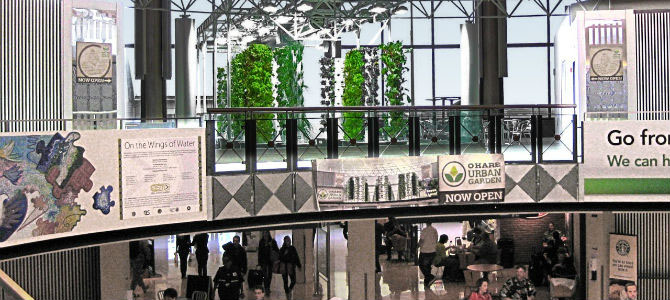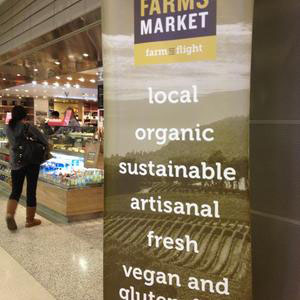While rushing to board your next flight, you might not expect farmers’ markets and urban farms among the airport’s fast food joints, mani-pedi stations, and newsstands. At four U.S. airports, however, travelers are encountering exactly that. Check out how the local food movement has arrived at airline terminals in New York, Chicago, San Francisco, and Los Angeles.
JetBlue’s Pop-Up Farmers’ Market at New York’s JFK
From October 29-31, JetBlue hosted a pop-up farmers’ market at New York’s John F. Kennedy Airport in partnership with GrowNYC, which operates the city’s 52 greenmarkets. The market, located beyond security in Terminal 5, featured items designed to appeal to both passengers boarding a flight and arriving travelers who wanted to pick up something healthy to eat or give as a gift. The products were all grown or made in New York state, including baked goods, grains, honey, jams, maple syrup, fruit, pickles, tomato sauces, wine, beer, and hard cider. The market also included education stations, a harvest-themed photo booth, a bike blender for people-powered smoothies, a compost pile with live worms, and a recycling game.
“When you think of an airport, farms and composting do not automatically come to mind,” said Sophia Mendelsohn, JetBlue’s head of sustainability. “We are connecting the two because we know sustainability is an ongoing cycle. The nutritious scraps of food we compost in T5 are returned to the ground to help make New York produce.” The airline started a composting program in May with Air Ventures, the franchisee that owns and operates the Jamba Juice and Dunkin Donuts restaurants in the terminal, and Royal Waste Services to separate and haul nearly 300 pounds of food waste each day for composting. Food scraps are transported to McEnroe Farm in New York’s Hudson River Valley where it is composted into nutrient-rich soil and used to grow produce.
While the JFK farmers’ market was a short-term test, the airline has not ruled out hosting the concept again in New York or other cities.
 At O'Hare Airport's aeroponic garden, plants are harvested year-round and supply airport restaurants.
At O'Hare Airport's aeroponic garden, plants are harvested year-round and supply airport restaurants.**Aeroponic Urban Garden at Chicago’s O’Hare Airport**
Installed in the summer of 2011 as a joint collaboration between the Chicago Department of Aviation (CDA) and the HMS Host Corporation, O’Hare’s 928-square-foot [aeroponic garden](http://www.flychicago.com/OHare/EN/AboutUs/Sustainability/Aeroponic-Garden.aspx) is the first of its kind to be located in an airport.
Located on the mezzanine level of Terminal 3, the plants are suspended in 26 PVC towers that employ sustainable “green” technology, developed by Future Growing LLC, to grow more than 1,100 plants, including a variety of culinary herbs, gourmet lettuces, leafy greens, and other vegetables. The plants are harvested year-round and supply airport restaurants such as Tortas Frontera, Wolfgang Puck, and Wicker Park Sushi, meaning the produce may go only 20 feet from farm to table. In addition, some of the “living lettuce”—with roots intact for premium freshness—is harvested, packaged in biodegradable clamshells, and sold to airport guests. By avoiding the need to transport produce over long distances, the O’Hare urban garden plants can be picked at the peak of ripeness, thus providing both greater nutrition and more flavorful produce.
Producing and purchasing locally grown foods supports the CDA’s commitment to sustainability by strengthening the local economy and job market, providing a unique learning opportunity for travelers, and reducing urban sprawl, traffic congestion, habitat loss, and pollution from transportation of produce.
 Napa Farms Market inside Terminal 2 at the San Francisco Airport. Photo: Vickie Clampett</div></p>
**Napa Farms Market at San Francisco Airport**
Napa Farms Market inside Terminal 2 at the San Francisco Airport. Photo: Vickie Clampett</div></p>
**Napa Farms Market at San Francisco Airport**Modeled after San Francisco’s famous [Ferry Building Marketplace](http://www.ferrybuildingmarketplace.com), the 5,000-square-foot Napa Farms Market inside Terminal 2 at the San Francisco Airport opened in April 2011. The market’s mission is to sell fresh, sustainable products from local brands like Equator Coffee, Tyler Florence's Rotisserie, Cow Girl Creamery, Kara’s Cupcakes, Vino Volo, and Acme Bakery. The market was developed by [Tastes on the Fly](http://www.tastesonthefly.com), four Bay Area restaurant entrepreneurs who joined forces in 1999 to develop and operate food-and-beverage concepts in U.S. airports. To ensure authenticity, they worked with retail marketplace developer Steve Carlin, who spearheaded the San Francisco Ferry Building Marketplace and founded Napa’s Oxbow Public Market. </p>
Plans for Farmers Market To Go at Los Angeles Airport
After nearly 80 years at Third and Fairfax in Los Angeles, the Original Farmers Market is expanding with a new location at Los Angeles International Airport. Scheduled to open early next year in Delta Air Lines Terminal 5, the mini market will offer selected goods from Original Farmers Market sellers, including wines and cheeses from Monsieur Marcel Gourmet Market, nuts and nut butters from Magee’s House of Nuts, authentic Mexican cuisine from ¡Loteria! Grill, baked pastries and desserts from T & Y Bakery, Bennett’s Ice Cream, spices from Dragunara Spice Bazaar, and treats for travelling pups from Three Dog Bakery. In addition to the market, meals-to-go and on-site dining will be available. The airport market also will have iPads and kiosks that provide fun facts about Market merchants and their shops.
Sustainable America supports growing, buying, and eating more locally sourced, fresh food, as well as initiatives like locating farmers’ markets and urban farms in unexpected locations to increase people’s awareness of and access to local food systems. Alternative farming methods, which currently total about 3 percent of U.S. food production, have the potential to increase our food supply while reducing energy use. To help head off an impending food and fuel crisis, Sustainable America aims to reduce U.S. oil consumption by 50% by 2030 while increasing U.S. food availability by 50% by 2035.
